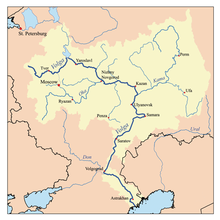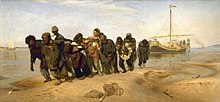Steam navigation on the Volga
The Volga, the longest river in Europe, is a key trade route in Russia . The development of the steam engine made it possible to transport freight upstream more efficiently, and steam navigation on the Volga itself began in 1821.
history
Burlaken
Originally, the freight traffic on the Volga was thousands as Burlaken called Treidler settled. These pulled the boats up the Volga and its tributaries. Horses were also used for towing. The Burlaken were replaced in large numbers by steamers from around 1840 onwards .
First steamships

In 1843 Tsar Nicholas II granted a license to the company "Along the Volga", which remained the main provider of transport services on the Volga until the Soviets took over. The first steamship Volga reached Samara in 1846. Nizhny Novgorod became the main transshipment point for shipping. Although the first steamship had already been tested in 1821, steam navigation only achieved a high volume of traffic from 1845.
The first large steamers to sail on the river were built according to American models in 1872. In 1870 the first Siemens-Martin furnace was built in Nizhny Novgorod ; The steamship Perevorot with two decks was built in 1871 in the associated shipyard . In 1913 the Danilikha cargo ship was built . The shipyard built 489 ships between 1849 and 1918. In 1913 more than 5,000 steamships operated on the Volga.

Development from 1890
In 1897 40 people drowned in a collision between the ships Tsarevich and Malpitka near Astrakhan .
In 1858 a machine factory in Nizhny Novgorod completed the first Russian steam dredger. The introduction of steam dredgers made it possible to improve the navigability of the Volga, which was impaired by erosion and material removal. The Volga tends to quickly erode banks, and settlements and ports often had to be relocated.
Under the direction of Alfred Nobel , 50 ships were built in Baku to transport oil from the Caspian Sea . Nobel constructed the ship Vandal in Baku in 1903 , which is believed to be the first diesel-powered ship. In 1902 Karl Hagelin suggested equipping barges with diesel drives. He developed a concept for shipping oil over 2,900 kilometers from the Lower Volga to St. Petersburg and Finland. From 1908 to 1917 the Nobels shipyard in Rybinsk built the Komar , Schmel and Tungus ships , among others .
Interwar period
The Soviets operated a fleet of armed steamers during the Russian Civil War . Several small battles were fought on the river between the Red Army and the White Army . During the Russian famine of 1921 , numerous food shipments were made across the river. After the victory of the Red Army, the damaged infrastructure was rebuilt. Under the Soviet rule, the fleets of the various shipping companies were nationalized.
In 1926, 1,604 steamships with a combined power of 300,595 horsepower were in service on the Volga. The Volga fleet was thus the largest of the Soviet inland fleets. On January 1st, 1927, the inland fleets had 2,020 steamers on all rivers. During the Russian Civil War, around half of the existing fleet was destroyed.
World War II and post-war period
At the beginning of the Battle of Stalingrad , even before the Wehrmacht reached the city itself, the German Air Force had brought shipping traffic on the Volga, which was mainly used to supply the city, to a standstill. Between July 25 and 31, 1942, 32 Soviet ships were sunk and 9 others were damaged. The tugboat Krasnoflotets succeeded in transporting several boats with soldiers, food and ammunition into the city. A hospital ship was hit 11 times by National Socialist artillery.
The tugboat Gasitel gained fame when it towed some oil barges on July 27, 1942 and thus saved them from a fire. The same ship was used as a ferry before it sank in mid-October. Captain Peter Wasiliewitsch Vorobiew was awarded the Order of the Red Banner .
The Soviet Navy equipped several cutters with turrets from the T 34 tank . The Volga flotilla is attributed an essential role in the defense of the city, as it kept the supply lines open and brought reinforcements and ammunition into the city and the wounded from the combat area. During the war, around 200 million tons of goods for military use were transported on the river. The war severely damaged the infrastructure, the Nazi troops sank 8,300 ships and destroyed hundreds of ports, shipyards, dams, dykes and locks.
Freight transport on the Volga was restored during the 5th four-year plan from 1946 to 1950. After the war, numerous dams, canals, dams, reservoirs and hydroelectric power stations were built, most of which were planned before the outbreak of war. One focus of the hydraulic engineering activities was the control of erosion and siltation. The Volga-Don Canal and the Volga-Baltic Sea Canal have improved the transport options for Volga shipping. Until 1950, paddle steamers were mainly used, the Ryazan class , which was manufactured from 1951 to 1959, was designed as a side paddle steamers . From 1960 hydrofoils and diesel tugs were increasingly used.
literature
- George H. Bartlett: To Samara from Moscow, via Nizhni and the River Volga. In: The Harvester world. Vol. 2-3, International Harvester Co., 1910, p. 22, books.google.com (description of a voyage by an International Harvester Co. seller on a steamboat on the Volga in 1910).
- William T. Ellis: Voyaging on the Volga Amid War and Revolution. In: National Geographic Magazine. Volume 33, 1918, p. 245, books.google.com .
- Robert Gardiner, Ambrose Greenway: The golden age of shipping: the classic merchant ship, 1900-1960. Conway Maritime, 1994, ISBN 0-85177-567-5 , books.google.com .
- Walter Graebner: 1000 Miles up the Volga. In: Life magazine, September 7, 1942, p. 2, books.google.com (Describes a journey on the Volga during World War II).
- Vasili I. Chuikov: The Beginning of the Road: The Story of the Battle for Stalingrad. MacGibbon & Kee, London 1963.
- Donald E. Thomas: Diesel: Technology And Society In Industrial Germany. University of Alabama Press, 2004, ISBN 0-8173-5170-1 , books.google.com .
- Robert Tolf: The Russian Rockefellers: the saga of the Nobel family and the Russian oil industry. Hoover Press, 1976, ISBN 0-8179-6581-5 , books.google.com .
- United States Dept. of Commerce, Special Consular Reports. Volume 13, No. 1, p. 394, books.google.com (Describes ships, routes and tariffs on the Volga and its tributaries in 1895).
- CIA. Soviet Shipping. Washington. 1950.
Individual evidence
- ↑ Samara Tourist Guide: Samara Travel Guide . In: myeuropeholidays.com . 2011. Archived from the original on August 9, 2011. Info: The archive link was automatically inserted and has not yet been checked. Please check the original and archive link according to the instructions and then remove this notice. Retrieved July 4, 2011: "The first steamer 'Volga' visited to Samara in 1846."
- ↑ FORTY DROWNED IN THE VOLGA. - Steamer Tsarevitch Run Down by the Malpitka Near Astrakhan. - View Article - NYTimes.com . In: The New York Times , September 17, 1897. Retrieved July 4, 2011.
- ↑ Naval-engineers.Com: All About Naval Engineering: History of Shipping Industry . In: naval-engineers.blogspot.com . 2011. Retrieved July 4, 2011: "In 1903 the Wandal, a steamer on the Volga River, was powered by the first diesel engine used for ship propulsion."
- ↑ sources disagree over whether, Vandal or Petite-Pierre, was the first diesel ship: Thomas, p. 207: Petite-Pierre was the first diesel ship. Gardiner and Greenway, p. 160: Vandal was the first diesel ship.
- ↑ a b Tolf, p. 171.
- ^ Nobel Shipyard: About Company . In: nobel-shipyard.ru . 2011. Retrieved July 4, 2011.
- ↑ a b c Bertrand M. Patenaude: Food as a Weapon | Hoover Institution . In: hoover.org . 2011. Archived from the original on May 29, 2014. Info: The archive link was inserted automatically and has not yet been checked. Please check the original and archive link according to the instructions and then remove this notice. Retrieved July 5, 2011.
- ^ The Soviet Union: Facts, Descriptions, Statistics - Ch 8 . In: marxists.org . 2009. Accessed July 4. 2011.
- ^ Battle of Stalingrad. In: Encyclopædia Britannica. Quote: “By the end of August,… Gen. Friedrich Paulus, with 330,000 of the German army's finest troops ... approached Stalingrad. On August 23 a German spearhead penetrated the city's northern suburbs, and the Luftwaffe rained incendiary bombs that destroyed most of the city's wooden housing. "
- ↑ Avalanche Press: 119694_avalanche Press . In: avalanchepress.com . 2011. Retrieved July 4, 2011: "I would say briefly that had it not been for them the 62nd Army might have perished without ammunition and rations, and could not have carried out its task."
- ^ John Keegan : The Battle for History: Re-fighting World War Two (= Barbara Frum lecture series), Vintage Canada, Toronto 1995. Republished by Vintage Books, New York, 1996, p. 121.


